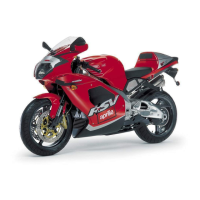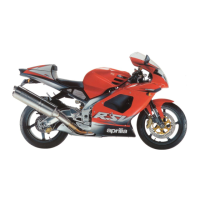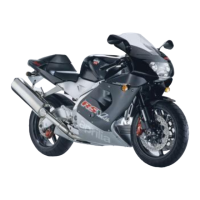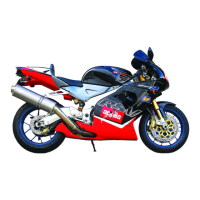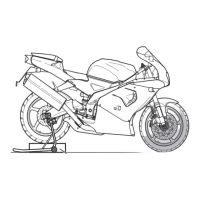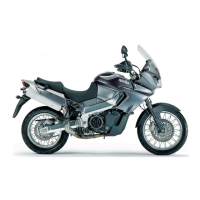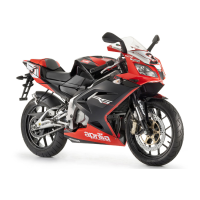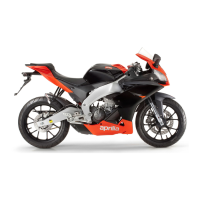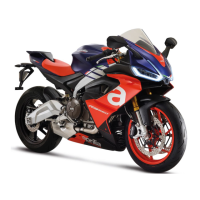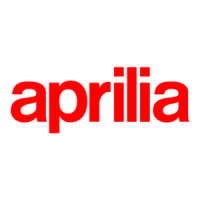
Do you have a question about the APRILIA RST mille FUTURA and is the answer not in the manual?
| Engine Type | V-Twin, 4-stroke |
|---|---|
| Displacement | 998 cc |
| Fuel System | Electronic Fuel injection |
| Transmission | 6-speed |
| Power | 84 kW (114 hp) @ 9250 rpm |
| Torque | 95 Nm (70.1 ft-lbs) @ 7250 rpm |
| Front Brakes | Dual 320 mm discs, 4-piston calipers |
| Rear Brakes | 220mm disc, 2-piston caliper |
| Fuel Capacity | 21 liters (5.5 gallons) |
| Cooling | Liquid |
Indicates potential hazard for serious injury or death.
Indicates potential hazard for minor injury or damage.
Includes NOTE usage and technical information like bulb spares.
License, age, psychophysical condition, and general fitness to drive.
Impact of alcohol/drugs, and rules on lending the vehicle.
Observe road signs, avoid abrupt movements, and consider conditions.
Correct posture, avoiding obstacles and slipstream riding.
Stay attentive while driving and regularly check fluid levels.
Inspect for damage after accidents and report any malfunctions.
Avoid unauthorized changes to vehicle parts; they invalidate the guarantee.
Wear approved helmet and gear, ensuring proper fit and fastening.
Proper accessory installation and caution against electrical modifications.
Distribute luggage evenly on both sides and secure it firmly.
Avoid handlebar objects; secure bags tightly to prevent loss of control.
Adhere to maximum load limits for side bags and avoid carrying animals/children.
Diagram and key identifying main components on the left side.
Diagram and key identifying main components on the right side.
Operation of horn, turn signals, and high/low beam selector.
Engine stop switch, light switch, and starter button.
Layout of instruments and indicators on the dashboard.
Detailed diagram of instruments with a key for each indicator and display.
Explains the function of various LED warning lights on the dashboard.
Function of neutral light, ignition test, and fixed setting notes.
EFI warning light meaning and display of speed and distance covered.
How fuel level is shown and the option to display air temperature.
Detailed function of the air temperature display and its readings.
Advice for driving in cold conditions, potential ice formation.
Displays coolant temperature and indicates when service is due.
Function of the clock display and how to set the time.
Explains the operation of the various buttons for setting adjustments.
How to adjust the intensity of the dashboard lighting.
Switching between metric/imperial units for speed, fuel, and temp.
How to switch between total and partial kilometre readings.
Alternating the display between fuel level and air temperature.
Step-by-step guide to setting the clock's hours and minutes.
Operation of horn, turn signals, and high/low beam selector.
Using the high beam flash for signaling to other vehicles.
Safety stop function and controls for parking, dashboard, and low beams.
The button used to activate the starter motor for engine ignition.
Describes the key positions (Lock, OFF, ON, Park) and their effects.
How the key operates the ignition, fuel tank, and saddle locks.
Step-by-step instructions on how to lock and unlock the steering.
Function of parking lights for visibility and battery caution.
Procedure for opening and closing the rider's saddle.
Lists the tools included in the under-seat compartment.
Tools recommended for specific maintenance operations.
Approved accessories like side bags and their proper mounting.
Warnings regarding fuel flammability, ventilation, and static electricity.
How to refuel the tank, including capacity and reserve.
Precautions against spills, additives, and post-refueling checks.
Handling brake fluid safely, including contact precautions and disposal.
Checking brake discs for cleanliness and cables for wear.
Importance of brake system function, fluid levels, and pad wear.
Cleaning discs, replacing pads, and fluid change intervals.
Increased maintenance in harsh conditions and warning about leaks.
Procedure to check the front brake fluid level against the MIN mark.
Steps and cautions for adding front brake fluid.
Steps for opening and closing the front brake fluid reservoir.
Topping up to MAX level and checking braking efficiency.
Procedure to check rear brake fluid level against MIN/MAX marks.
Steps and cautions for adding rear brake fluid.
Hydraulic clutch operation and safe handling of clutch fluid.
Checking clutch lever issues and cable condition.
Procedure to check clutch fluid level against the MIN mark.
Steps and cautions for adding clutch fluid.
Steps for opening and closing the clutch fluid reservoir.
Topping up to MAX level and checking clutch efficiency.
Warnings about low coolant level, toxicity, and contact.
Coolant mixture and adjusting antifreeze concentration.
Caution against opening the expansion tank when the engine is hot.
Procedure to check coolant level with a cold engine using marks.
Steps and precautions for adding coolant to the expansion tank.
Checking tyre pressure, condition, and wear indicators.
Procedures for tyre replacement, balancing, and recommended types.
Safe handling of engine oil, skin contact, and proper disposal.
Action for low oil pressure and procedure for checking oil level.
Information on oil change intervals and recommended oil specifications.
Adjusting the distance of the brake and clutch levers from the grip.
Adjusting the rear brake lever height and ensuring proper free play.
Procedure for adjusting the height of the gear shift lever.
How the automatic light system operates and its limitations.
Warnings about catalytic converter heat and exhaust system checks.
